Bombing of Tokyo and Other Cities
Contributor: C. Peter Chen
ww2dbaseThis article covers the conventional bombing of Japanese cities. For details on the atomic bombing, please see the article dedicated to Hiroshima and Nagasaki.
ww2dbaseBombing of Tokyo
The first of the long-range bombing raids on the Japanese home islands took place as early as 28 Nov 1944, mainly from the newly constructed air fields in the Mariana Islands. In Jan 1945, American General Curtis LeMay took over the 20th and 21st Bomber Commands, merging them into the XX Air Force. The XX Air Force immediately took on the task of bombing Japanese naval and air bases from high altitude, though most of the early attacks achieved relatively little.
ww2dbaseIn the spring of 1945, the B-29 Superfortress bombers were transferred to the XXI Bomber Command based at Guam, Mariana Islands. With increased scale, intensity, and frequency, the bombing campaign began to rain considerable destruction on Japanese cities. Tokyo, being the Japanese capital, received a greater share of attention from American bombers. The XXI Bomber Command missions on Tokyo and surrounding areas in 1945 were as follows.
- 19 Feb: 119 B-29 bombers hit the port and Tokyo urban areas.
- Night of 24-25 Feb: 174 B-29 bombers dropped incendiary bombs and destroyed about 3 square kilometer of the city, or about 28,000 buildings.
- 4 Mar: 159 B-29 bombers attacked Tokyo urban areas.
- Night of 9-10 Mar, Operation Meetinghouse: 279 B-29 bombers dropped incendiary bombs and destroyed 267,000 buildings and homes or 41 square kilometers of Tokyo. Americans estimated 88,000 killed, 41,000 injured, and 1,000,000 displaced. Tokyo Fire Department estimated 97,000 killed and 125,000 wounded. Tokyo Metropolitan Police Department estimated 124,711 casualties and 286,358 destroyed buildings and homes.
- 2 Apr: More than 100 B-29 bombers attacked the Nakajima aircraft factory.
- 3 Apr: 68 B-29 bombers attacked the Koizuimi aircraft factory and Tokyo urban areas.
- 7 Apr: 101 B-29 bombers attacked the Nakajima aircraft factory.
- 13 Apr: More than 300 B-29 bombers attacked military targets in and near Tokyo.
- 15 Apr: 109 B-29 bombers attacked Tokyo urban areas.
- 26 Apr: 464 B-29 bombers attacked Tokyo urban areas south of the Imperial Palace.
- 24 May: 520 B-29 bombers attacked urban and industrial areas south of the Imperial Palace.
- 20 Jul: A B-29 bomber failed to attack the Imperial Palace with a large "Pumpkin bomb".
- 8 Aug: About 60 B-29 bombers attacked aircraft factories and arsenals near Tokyo.
- 10 Aug: 70 B-29 bombers attacked the arsenal complex near Tokyo.
ww2dbaseYutaka Akabane, a senior level civil servant, observed that
ww2dbaseBy the time of the Japanese surrender, 50% of Tokyo was reduced to rubble.
ww2dbaseBombing of Kobe
ww2dbaseTokyo was not the only Japanese city targeted by American bombing in 1945. The city of Kobe, Japan, also suffered from American bombing.
- 17 Mar: 331 B-29 bombers destroyed 7 square kilometers of Kobe; 8,841 were killed and 650,000 were displaced.
- 11 May: 92 B-29 bombers attacked the Kawanishi aircraft factories.
- 5 Jun: 473 B-29 bombers destroyed 11 square kilometers of Kobe urban areas.
- 18 Jun: 25 B-29 bombers laid naval mines in several areas including waters near Kobe.
- 28 Jun: 29 B-29 bombers laid naval mines in three harbors including Kobe.
- 19 Jul: 27 B-29 bombers laid naval mines in several areas including waters near Kobe.
- 30 Jul: Fighters attacked airfields, railroads, and tactical targets in the Kobe-Osaka region.
ww2dbaseEffect of Conventional Bombing on Japanese Cities
ww2dbaseThe table below notes the effect of conventional bombing campaigns on Japanese cities.
| City Name | % Area Destroyed |
|---|---|
| Yokohama | 58.0 |
| Tokyo | 51.0 |
| Toyama | 99.0 |
| Nagoya | 40.0 |
| Osaka | 35.1 |
| Nishinomiya | 11.9 |
| Shimonoseki | 37.6 |
| Kure | 41.9 |
| Kobe | 55.7 |
| Omuta | 35.8 |
| Wakayama | 50.0 |
| Kawasaki | 36.2 |
| Okayama | 68.9 |
| Yawata | 21.2 |
| Kagoshima | 63.4 |
| Amagasaki | 18.9 |
| Sasebo | 41.4 |
| Moji | 23.3 |
| Miyakonojo | 26.5 |
| Nobeoka | 25.2 |
| Miyazaki | 26.1 |
| Ube | 20.7 |
| Saga | 44.2 |
| Imabari | 63.9 |
| Matsuyama | 64.0 |
| Fukui | 86.0 |
| Tokushima | 85.2 |
| Sakai | 48.2 |
| Hachioji | 65.0 |
| Kumamoto | 31.2 |
| Isesaki | 56.7 |
| Takamatsu | 67.5 |
| Akashi | 50.2 |
| Fukuyama | 80.9 |
| Aomori | 30.0 |
| Okazaki | 32.2 |
| Oita | 28.2 |
| Hiratsuka | 48.4 |
| Tokuyama | 48.3 |
| Yokkaichi | 33.6 |
| Ujiyamada | 41.3 |
| Ogaki | 39.5 |
| Gifu | 63.6 |
| Shizuoka | 66.1 |
| Himeji | 49.4 |
| Fukuoka | 24.1 |
| Kochi | 55.2 |
| Shimizu | 42.0 |
| Omura | 33.1 |
| Chiba | 41.0 |
| Ichinomiya | 56.3 |
| Nara | 69.3 |
| Tsu | 69.3 |
| Kuwana | 75.0 |
| Toyohashi | 61.9 |
| Numazu | 42.3 |
| Choshi | 44.2 |
| Kofu | 78.6 |
| Utsunomiya | 43.7 |
| Mito | 68.9 |
| Sendai | 21.9 |
| Tsuruga | 65.1 |
| Nagaoka | 64.9 |
| Hitachi | 72.0 |
| Kumagaya | 55.1 |
| Hamamatsu | 60.3 |
| Maebashi | 64.2 |
ww2dbaseThe attack on these major cities caused as many as 500,000 Japanese deaths, while displacing as many as 5,000,000.
ww2dbaseSources: The Pacific Campaign, Wikipedia.
Last Major Update: Mar 2008
Bombing of Tokyo and Other Cities Interactive Map
Photographs
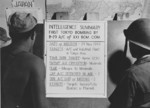 | 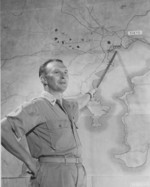 | 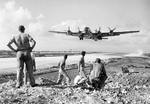 | 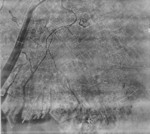 |
Maps
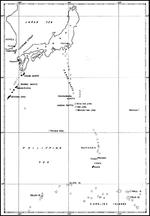 | 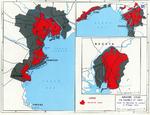 | 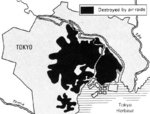 |
Bombing of Tokyo and Other Cities Timeline
| 18 Jul 1943 | 6 American B-24 bombers attacked Japanese shipping between Paramushiru Island and Shimushu Island in the Kurile Islands and the Kataoka Airfield on Paramushiru; this was the first heavy bomber attack against Japan. |
| 29 Nov 1943 | American B-29 bombers attacked the Nakajima factory outside Tokyo, Japan. |
| 10 Apr 1944 | The US Joint Chiefs of Staff formally approved Operation Matterhorn, the name allocated to the B-29 bomber offensive against Japanese cities. |
| 15 Jun 1944 | American B-29 bombers based in China conducted a raid on Japan. |
| 7 Aug 1944 | A Japanese aircraft made the first aerial ramming attempt at an American bomber. |
| 10 Aug 1944 | 29 B-29 Superfortress bombers of US 20th Bomb Squadron took off from Chengdu, Sichuan Province, China for Nagasaki, Japan. 24 of them would arrive over the Japanese city just before midnight. |
| 11 Aug 1944 | 24 China-based B-29 Superfortress bombers of US 20th Bomb Squadron attacked Nagasaki, Japan between about midnight until 0312 hours. They targeted industrial areas, but most of the bombs ended up exploding in the damp forest near Oyama and Mount Hiko. 9 homes were destroyed, about 50 homes were damaged, 13 people were killed, and 26 people were seriously injured. |
| 24 Nov 1944 | The first B-29 bombing raid against Tokyo, Japan from Tinian in the Mariana Islands took place; 88 American aircraft participated in this mission. |
| 3 Jan 1945 | 57 American B-29 bombers attacked Nagoya, Japan, while 21 other bombers attacked other Japanese cities. |
| 27 Jan 1945 | 62 American B-29 bombers based in the Mariana Islands struck Tokyo, Japan. Japanese fighters shot down 5 bombers, while 4 others received damage and had to ditch or crash land. B-29 gunner claimed 60 fighters shot down. |
| 4 Feb 1945 | Seventy American B-29 Superfortress bombers dropped 160 tons of incendiaries on the Japanese city of Kobe. Most of its building were made of wood and they blazed instantly. |
| 10 Feb 1945 | The Nakajima aircraft plant at Ota, Gunma Prefecture, Japan was seriously damaged by American bombing. |
| 19 Feb 1945 | 119 American B-29 bombers attacked the port and urban areas of Tokyo, Japan. |
| 24 Feb 1945 | During the night of 24-25 Feb, 174 American B-29 bombers dropped incendiary bombs on Tokyo, Japan and destroyed about 3 square kilometers of the city, or about 28,000 buildings. |
| 4 Mar 1945 | The United States adopted a policy of carpet bombing Japanese cities as opposed to precision strikes. |
| 4 Mar 1945 | 159 American B-29 bombers attacked the urban areas of Tokyo, Japan. |
| 9 Mar 1945 | Operation Meetinghouse: After sundown and into the early hours of 10 Mar, 279 American B-29 bombers dropped incendiary bombs on Tokyo, Japan and destroyed 267,000 buildings and homes or 41 square kilometers of the city. Americans estimated 88,000 killed, 41,000 injured, and 1,000,000 displaced. Tokyo Fire Department estimated 97,000 killed and 125,000 wounded. Tokyo Metropolitan Police Department estimated 124,711 casualties and 286,358 destroyed buildings and homes. |
| 11 Mar 1945 | 285 American B-29 bombers attacked the Nagoya, Japan urban area with incendiary bombs. |
| 13 Mar 1945 | 274 US aircraft bombed and destroyed 8.1 square miles of Osaka, Japan. |
| 16 Mar 1945 | 307 US B-29 bombers devastated a 3-square mile area in Kobe, Japan and caused 15,000 in casualties. |
| 17 Mar 1945 | 331 US B-29 bombers destroyed 7 square kilometers of Kobe, Japan; 8,841 were killed and 650,000 were displaced. The US attack also heavily damaged submarine I-15, which was under-construction at Kobe, nearly completed. |
| 19 Mar 1945 | In Japan, aircraft of US Navy TF 58 attacked targets on Kyushu and Honshu (Kure, Osaka, and Kobe), destroying submarine I-205 (still under construction) and damaging many warships. |
| 2 Apr 1945 | In Japan, 100 American B-29 bombers conducted a raid on the Nakajima aircraft factory near Tokyo, while 15 B-29 bombers mined waters off Kure and Hiroshima. |
| 3 Apr 1945 | 68 American B-29 bombers attacked the Koizuimi aircraft factory and the urban areas of Tokyo, Japan. |
| 7 Apr 1945 | 101 American B-29 bombers attacked the Nakajima aircraft factory near Tokyo, Japan; this was the first B-29 mission to be escorted by P-51 fighters from Iwo Jima. |
| 26 Apr 1945 | In Japan, 464 American B-29 bombers attacked the urban areas of Tokyo, Japan south of the Imperial Palace. |
| 26 Apr 1945 | One US B-29 Superfortress bomber attacked Nagasaki, Japan at 1100 hours, having arrived undetected. The main targets were Dejima Wharf, Ohato Pier, and the rail station complex. About 30 people were killed or wounded aboard municipal ferries Tsuru Maru and Mizunoura Maru at Ohato Pier, while the bomb that fell near Platform No. 2 at the rail station killed about 90 people, wounded about 170 people, and severely damaged three passenger cars. The bomb that fell on Dejima Wharf failed to explode. |
| 5 May 1945 | The Hiro Naval Arsenal in Kure, Japan was destroyed by US B-29 Superfortress bombers. |
| 11 May 1945 | 92 American B-29 bombers attacked the Kawanishi aircraft factories near Kobe, Japan. |
| 14 May 1945 | US Navy carrier aircraft strafed targets in Nagasaki, Japan. |
| 14 May 1945 | 472 American B-29 bombers conducted a raid on Nagoya, Japan as part of the first of two days of saturation bombing on Japanese cities. The Americans would drop 16,000 tons of napalm and oil bombs during the campaign; vast areas were burned out but 77 B-29 bombers failed to return. |
| 17 May 1945 | 470 American B-29 bombers conducted a raid on Nagoya, Japan. |
| 19 May 1945 | 272 B-29 Superfortress bombers struck Hamamatsu, Japan. |
| 23 May 1945 | 525 American B-29 bombers conducted a raid on Tokyo, Japan. |
| 24 May 1945 | Aircraft of US Navy Task Force 58 attacked airfields in southern Kyushu, Japan while 520 US Army B-29 bombers attacked urban and industrial areas south of the Imperial Palace in Tokyo. Many buildings on the grounds of the Imperial Palace complex were destroyed. |
| 25 May 1945 | 464 American B-29 bombers conducted a raid on Tokyo, Japan. 26 aircraft were lost, which was the highest one-day loss. |
| 29 May 1945 | American B-25 bombers from Okinawa conducted a raid on Tokyo, Japan, while 454 B-29 bombers (escorted by 101 P-51 fighters) firebombed Yokohama, Japan. |
| 1 Jun 1945 | 458 American B-29 bombers attacked Osaka harbor, Japan in poor weather. 148 P-51 Mustang fighters flew in escort, and 27 were lost, many due to collisions due to poor visibility. 6 ships were sunk by the attack while another 6 were damaged; many naval mines were also laid in the harbor. |
| 5 Jun 1945 | 473 American B-29 bombers destroyed 11 square kilometers of urban areas at Kobe, Japan. |
| 7 Jun 1945 | 400 American B-29 bombers attacked Osaka, Japan. |
| 16 Jun 1945 | Submarines USS Silversides, USS Quillback, and USS Cabrilla arrived in their patrol area roughly midway between Iwo Jima and Tokyo. Their orders emphasized remaining available for lifeguard duty as numerous B-29 bombers flew overhead from the Mariana Islands to Japan and back. |
| 28 Jun 1945 | The US War Department ordered 150 million incendiary bombs, amounting to some 850,000 tons, to be employed over the next twelve months against Japanese industrial targets. |
| 29 Jun 1945 | After spending the night on lifeguard station during a 487-bomber B-29 incendiary raid on Japan, Gato-class submarine USS Silversides was directed by aircraft from air-sea-rescue to possible downed airmen in the water. One empty well-weathered one-man life raft was recovered. |
| 1 Jul 1945 | More than 530 American B-29 bombers attacked various cities in Japan with incendiary bombs. |
| 4 Jul 1945 | B-29 bombers of the US Army Far East Air Force aircraft attacked Kyushu, Japan from their bases in the Philippine Islands. |
| 5 Jul 1945 | American B-24 bombers based on Okinawa, Japan bombed the Omura-Nagasaki area in the Japanese home islands. On the same day, more than 100 American fighters based on Iwo Jima, Japan attacked targets in eastern Honshu in the Japanese home islands. |
| 6 Jul 1945 | 517 American B-29 bombers from the Mariana Islands dropped incendiary bombs on Japan. |
| 10 Jul 1945 | The US Army Air Forces launched the first of several 1,000-bomber raids against the Japanese home islands. Meanwhile, US Navy aircraft from Essex-class carriers USS Yorktown and USS Shangri-La launched air strikes on the Tokyo area. |
| 12 Jul 1945 | More than 500 American B-29 bombers dropped incendiary bombs on a number of cities on Honshu, Japan. |
| 16 Jul 1945 | During the day, 5 American P-47 fighters attacked Yanagawa, Japan while 94 American P-51 fighters based in Iwo Jima attacked Kameyama, Kiyosu, Komaki, Okazaki, Suzuko, and Akenogahara. After sundown, four B-29 incendiary bombing missions were launched against Japanese cities, with 119 aircraft over Namazu (destroying 3.6 square kilometers of the city), 124 over Oita (1.437 square kilometers), 94 over Kuwana (1.63 square kilometers), and 129 over Hiratsuka (2.69 square kilometers); damage caused on all four cities were severe. |
| 19 Jul 1945 | After sundown, US 20th Air Force launched 27 B-29 Superfortress bombers to mine waters off Japan and Korea, 127 B-29 bombers to attack Fukui, 126 B-29 bombers to attack Hitachi, 91 B-29 bombers to attack Choshi, 126 B-29 bombers to attack Okazaki, and 83 B-29 bombers to attack the Nippon oil plant at Amagasaki; only 3 B-29 bombers were lost by the US 20th Air Force during this night. |
| 19 Jul 1945 | The Nagasaki Prefectural Government in Japan ordered all national elementary schools in the prefecture's five cities to move classes to sites such as shrines, private homes, and the likes as a safety measure to protect children against US bombing. |
| 20 Jul 1945 | US 11th Air Force launched 8 B-24 bombers against Matsuwa Airfield, Matsuwa, Hokkaido, Japan in the Kurile Islands. Meanwhile, 94 Iwo Jima-based US P-51 fighters strafed airfields at Kamezaki, Meiji, Okazaki, Nagoya, Kagamigahara, Hamamatsu, and Komaki; 3 fighters were lost. |
| 22 Jul 1945 | P-51 Mustangs flying from Iwo Jima made a fighter sweep of southern Japan. One fighter was badly damaged and the pilot had to bail out 15 miles off the Japanese coast. His parachute was seen from the lifeguard submarine USS Silversides who picked up the pilot, 2Lt James Hinkle, uninjured. |
| 23 Jul 1945 | American aviators reported the presence of barrage balloons 12,000 feet above Hitachi, Japan. |
| 27 Jul 1945 | USAAF bombers dropped 600,000 leaflets over 11 Japanese cities, warning civilians of bombing. |
| 29 Jul 1945 | 32 US A-26 aircraft attacked Nagasaki, Japan between 1000 and 1200 hours, dropping 51 tons of bombs and 6 tons of fragmentation bombs. The main target were the industrial facilities on the water. The ship fitting factory at the Mitsubishi shipyard was totally destroyed; several other industrial facilities nearby were also damaged. Merchant ship Sansui Maru No. 5 was sunk at its mooring at Akunoura. The attack also destroyed a 20-meter stretch of street car tracks, damaged the Nagasaki Teachers Training School, destroyed 43 homes, and damaged 113 homes. In total, 22 people were killed, 40 people were wounded, and 3 people were reported missing. |
| 31 Jul 1945 | 29 B-24 bombers of US 7th Air Force attacked Nagasaki, Japan in the morning, sinking ferry Kinko Maru, damaging the Kawanami Shipyard at Koyagishima, destroying 72 homes, and damaging 76 homes. 11 people were killed and 35 people were wounded. |
| 1 Aug 1945 | An incendiary attack by US B-29 bombers resulted in 95.6 percent destruction of the aluminium-producing city of Toyama, Japan. |
| 1 Aug 1945 | In the biggest air raid yet over Japan, 820 Superfortress bombers dropped 6,632 tons of high explosive bombs and incendiary bombs on four cities, bringing the total number of Japanese cities incinerated to 56. |
| 1 Aug 1945 | 24 B-24 and 26 B-25 bombers attacked Nagasaki, Japan, dropping 112 tons of bombs starting at about 1120 hours, in three waves. They mainly targeted the munitions factories and the Mitsubishi shipyard. In total, 169 people were killed, 215 people were wounded, 40 people were missing, 107 homes were destroyed, and 134 homes were damaged. The Mitsubishi shipyard, the Mitsubishi Steelworks, and the Nagasaki Medical College suffered heavy damage. The railroad tracks between Urakami and Nagayo were also damaged. |
| 3 Aug 1945 | 100 American fighters based in Iwo Jima, Japan attacked targets Tokyo, Japan. |
| 4 Aug 1945 | US Army B-25 bombers based on Okinawa, Japan attacked Takanabe, Kyushu, Japan, damaging or destroying warehouses, factories, railways, and a rail marshaling yard. |
| 8 Aug 1945 | About 60 American B-29 bombers attacked aircraft factories and arsenals near Tokyo, Japan. |
| 10 Aug 1945 | 70 US Army Air Forces B-29 bombers attacked the arsenal complex near Tokyo, Japan while US Navy carrier aircraft from USS Ticonderoga (Air Group 87), USS Shangri-La, and USS Yorktown struck targets on the islands of Hokkaido and Honshu. |
Did you enjoy this article or find this article helpful? If so, please consider supporting us on Patreon. Even $1 per month will go a long way! Thank you. Share this article with your friends: Stay updated with WW2DB: |
Visitor Submitted Comments
7 May 2009 06:45:13 PM
I am just wondering if there were Americans - missionaries, tourists,or businessmen when the bombing happened in Kumagaya.
9 Mar 2010 05:11:40 PM
Yes, there were surely American deaths in Japanese cities bombed. Including POW's near the sites of the A-bombs. Sorry about their luck. It had to be done.
9 Mar 2010 05:13:46 PM
I can't imagine there being American tourists or businessmen killed in Japan in those days. Missionaries and POW's were probably all that were there then.
13 Mar 2010 10:15:20 AM
It's amazing to learn the damage on these cities.The bombing of U.S. aircraft and now studying the aircraft and the Pacific Campaign ensures me the United States had to do what we did to be who we are today.I hope other countries will learn from the past and present. God Bless America.
18 Mar 2010 02:31:09 PM
Yes, I would say we had to do it. It has been reported that Japan and maybe Germany too were fairly close to testing their own a-bomb. Germany also had prototype long range bombers. Germany also had an ally very near us - Mexico. Yes, Mexico was sufficiently corrupt then, and in WWI also, to ally with Germany and other enemies of ours.
Does anyone think for a second that Germany and/or Japan would not have bombed our cities with nuclear and conventional bombs if they could have done so? It was theoretically possible, the technology existed but never matured into mass-production state although if some of Hitler's priorites had been just a little different it could have happened.
Also our industrial capability would have been the hardest thing for them to defeat, even if they had bombed somewhere. If they had succeeded in bombing Miami for example, they would have probably gotten away with it a few times, as they did with submarine attacks off the East coast, but we would have initiated action to defend against it and soon would have shot down their bomber fleet and they could never have built more of them as fast as we did.
That's how God blessed America back then. I fear however that we have strayed too far from God's laws to be eligible for many more of his blessings. In fact I think we are about done with God's blessings.
30 Mar 2010 09:24:53 AM
I don't think God has preferences to who wins or loses wars any more than He cares who wins or loses the Superbowl.
28 Apr 2010 02:33:02 AM
The killing of 100,000 civilians in an air raid is classified as Genocide - whatever the excuse. Had the US lost the war, its leaders would have been tried and executed for this and other crimes against humanity.
But the victors in a war rarely get punished for what they "had to do".
p.s. the causes of the war were complicated. The Japanese did not just bomb Pearl Harbor out of the blue.
8 Jul 2010 11:43:09 AM
Iām amazed that there are still so many people complaining about World War II. If you remember correctly we didnāt start the Second World War. Pearl Harbor was almost completely destroy on that Sunday morning in June. Over 6 thousands people died if I recall. These men were sound a sleep in their bunks when the Japanese attacked.
Iām sure all those men and women who help to retain your freedom didnāt ask for World War II either. So why do people still blame us for winning? Well, you can bet your life that both Germany and Japan would have destroyed us if they could have and everything that the American people stands for. Now, I have just one more thing to say then Iāll leave. If you donāt like the way things turned out then by all means āMOVE!ā
This is beginning to sound like Viet Nam.
Instead of always complaining about what we did during the war maybe we should āLEARNā from our mistakes so there wonāt be another war. Next time we may not be so lucky. Then again maybe this is what it will take for these people who are always complaining to grow-up and face the real world.
3 Aug 2010 08:33:30 AM
Remember pearl harbor?
That's what america has been doing
when the oil has been threatened each time...
It was planned by the US to be attacked first.
Which part of history did you learn?
The US setup the war.
Learn the right history!
YOU grow up and face the real world brother.
30 Jan 2011 05:43:08 AM
Post Number 10: Where is the proof?
25 Feb 2011 04:59:47 AM
War is always a bad thing to have to go through. Unfortunately it was necessary for us to defend ourselves from militarist counties bent on world conquest, such as Germany and Japan. We had to bomb their industrial areas to put an end to their ability to make war on us. The person who labeled Mexico as an ally of Germany in WWII is incorrect. The Mexican Air Force served in the Pacific against Japan.
7 Mar 2011 02:52:19 PM
wat about toyama, tokushima, fukui, fukuyama, tsu, kuwana, hitachi, nara, mito, shizuoka, tsurga, okayama, kofuand takamatsu?
15 Mar 2011 02:51:22 AM
Japan invaded China in July 1937 and for 8 years engaged in war. While the numbers people killed in the bombing raids are high, just remember Nanking or Unit 731, or any countries invaded by Japan. They were involved in genocide on a grand scale as a deliberate policy, not in a limited time frame as practised by the US military.
27 Aug 2011 09:59:09 PM
well done america, mass scale bombing of urban areas full of woman and children in retaliation for an attack on a naval base/ army airfield(due to illegal and crippling sanctions). you say the Japanese would have bombed your cities had they the ability then why didn't they bomb Honolulu whilst attacking the above? i'm ashamed of being an anglo saxon seeing this horrible pics
3 Jan 2012 08:00:58 PM
You people don't know the definition of a Total Industrial War. WWII was a Total Industrial War, all resources(people and machinery) from both sides put towards the war effort. Japan's people were part of the war industry, thus they could be targeted. It's not ethical by today's standards obviously, but it was Japan's goal to have every last man, woman, and child fight to the death for the Japanese homeland if the Allies invaded.
24 Jan 2012 08:23:17 AM
i had trouble with finding videos do you have any
10 Mar 2012 03:31:06 AM
In the film The Fog Of War, MaCamara lies, 101 citys were firebombed, 3/5's of all the houses in Japan were burned before September.
63 civilions were killed in Pearl Harbor.
Some said one million people died that Saturday morning in Tokyo, almost all were women or children. 97,000 would be less than 5% of the people sleeping in the 16 square miles that burned before dawn March 10th 1945.
My father was awarded the legion of Merit for designing the "mission" (at Rank Studios in England) to avoid burning the Emperor's Palace. American POW's were on the palace grounds.
10 Mar 2012 01:41:25 PM
After the Japanese took out the 7th fleet on Dec. 7th, with which we had been blockading their crude oil sources, they stopped.
Their next move, especially since many Japanese were living in South America, would be to bomb a small dam in Panama that would take years to rebuild and refill.
It's lake was the only way to move American ships, except Tierra del Fuego.
My father was set up for days in December of 1941 with film cameras overlooking the lake and canal, waiting for the obvious.
Never happed.
12 Mar 2012 02:45:10 PM
United States Department of the Interior says 53 civilions were killed at Pearl Harbor, 24 with Japanise surnames. Source: National Park Service, USS Arizona Memorial.
The largest number of forgein nationals killed in the towers on 911 were Pakiasanies. It was the cheapest rent in Manhaton, mostly occupied by Asian Companies.
30 Apr 2012 08:55:00 AM
good facts
30 Sep 2012 12:42:46 PM
Japan was responsible for about 15 million deaths during WW II, and most of these were fellow Asians in the so-called Co-prosperity Sphere. Had and invasion of the main islands of Japan been necessary I have seen estimates of 1 million Allied (mostly American) and 7 million Japanese casualties. Given this and the number of casualties from conventional bombing raids it is evident that the atomic bombing of Japan, on balance, actually spared many lives on both sides. Another factor in Japan's decision to surrender, overlooked by many, is that the Soviet Union had declared war on Japan and had invaded from the north. How can anyone feel any sympathy for Japan given its comduct in WW II and in China even before WW II? The Allies, primarily the USA, did what they had to do. What is really remarkable is the enlightened way the USA introduced democracy to Japan after the war.
22 Oct 2012 07:58:24 PM
āJapan's deed in Asia' cannot automatically justify the US raid, althogh the majority of Japanese today have no intension to accuse US for this genocide.(It was a WAR.)
āNanking Massacreā or 'unit 731'? It was only after the WW II that China started to claim about these, although they had enough chance to appeal them to the world even before WW II. Besides their 'evidences' are doubtful. It has been proved that most photographs they showed were either fake or taken from other sources.
For example, they use some photos of the victims of BOMBING OF TOKYO as that of Nanking. Another photo of unit 731's experiment on human body was actually taken in July 1937 by Japanese, as a press photo of the autopsy of one of the Japanese victims massacred by Chinese during the Tungchow Mutiny. Furthermore the number of Chinese victims is increasing ever since 1945, from 1.3 million to 40 million(or more)!
I think we need at least verify the FACTS before such a discussion.
29 Nov 2012 02:08:40 PM
I consider myself pretty liberal but one thing I can't abide is revisionist history. The war would have dragged on for 1 to 2 more years that is based on the allied plans for the military defeat of Japan. The price was projected to be up to 10 million killed and wounded. The bombs saved lives. End of story.
8 Dec 2012 02:50:13 PM
People who think that war is pick and choose are fools. War is horrible thats why its called a war. People seem to forget that the at Iwo Jima the US won the battle but lost over 3000 more men. It was estimated that if the US had invaded the main land of Japan that some 10 million Japanese and over a million Americans would have died. People dont seem to remember how fanatical the Japanese nation was it was the first time in warfare the US faced an enemy who was entirely willing to die for their cause. It took all of these air raids and 2 Atom bombs dropped before Japan would surrender. If that isnt a fanatical enemy then I dont know what one is.
13 Jan 2013 08:41:46 PM
Japan started it, the U.S. finished it, period. The Imperial Japanese Air and Naval Forces attacked Pearl Harbor without a declaration of war and a warning, therefore Japan violated interntional law when doing so and the U.S. was brought into war. Thousands of U.S. soldiers and tens of civilians, who were not fully aware they were at war with Japan, lost their lives, so the Pearl Harbor attack WAS NOT ACCEPTABLE by any standards.
You don't start a war for no reason then cry when your homeland gets hit. The Japanese civilians were NOT ALL innocent either, they were working in the factories and small-time worships making the all necessary tools of war (guns, tanks, planes, ships, etc) to armed their nation's military so they could continue to wage war on us using the manfactured weapons from the cities so therefore, civilians making these things were bombed to deny the resources to their nation's military to wage war. It was Total Warfare, Union General Sherman did the same thing during the American Civil War when he targeted both civilian and military assets during his "March to the Sea" in 1864 in Georgia.
Just to let you ignorant people know, the USAAF didn't even followed the policy of carpetbombings from the start. The British RAF came up with the idea of it in the 1st place when the German Luffwafe carpetbombed their cities first. As precision bombing tech was so poor these days, the RAF carpetbombed many German cities with incideciary bombs at night, killing tens of thousand civilians. The USAAF was against it and followed the policy of precision bombing by day where at least they could hit the targets more accurately and effiecently in some cases do work.
In the Pacific, the USAAF tried to follow the precision bombing on major Japanese cities but this time, Japan had dispersed most of the war industries into highly-populated urban areas so therefore civilian casualites cannot be avoided.
The USAAF decided to borrow the tactics that the British RAF used on German cities before to destroy targets in Japan. For several months in 1945, the USAAF carpetbombed major Japanese cities with indeciary bombs, killing tens of thousands civilians and this was mostly thanks to Japanese anti-aircraft fire and that the military industries were placed within right near the urban highly-populated areas.
Despite of the horrenderous death toll, the Japanese didn't give a hoot about surrender at all.
The U.S. Armed Forces were prepating to invade Japan, called Operation Downfall. The Battle of Okinawa cost about 200,000 U.S. and Japanese lives, almost half of the dead were civilians. The Japanese civilians throw themselves off the cliffs to commit suicide into falsely believing the American Army were bunch of evil monsters who loves to kill innocent people. It would had happened in "Operation Downfall" as well. The Japanese authorities was planning to send the entire military and it's civilian populace to repel the invaders using horrible and suicide-like methods. Civilians in Japan were trained with grenades, spears, babies, elderly, woman, and kids as suicide bombers, and the war of attrition strategy. The Japanese believed in their Bushido Code that suicide was more honorable than surrender. Look at the Middle East, many Islamic terrorists send kids as suicide bombers because of their ideology.
Therefore, the A-bombs was used against the cities of Hiroshima and Nagasaki and it brought Japan in the state of shock of surrendering which they did.
Japan is a fully democracy thanks to the USA.
18 Apr 2013 05:36:03 PM
In the battles leading to the Japanese home islands it became obvious that they were willing to suffer catastrophic losses rather than surrender. Military losses for example:
Iwo Jima: 22000 dead 216 surrendered
Saipan: 240000 dead (5000 civilian suicides) 921 surrendered
Tarawa: 4700 dead 17 surrendered
Okinawa: 107,000 dead 7400 surrendered
These were minor Japanese islands and they were willing to lose this amny people rather than surrender.The losses in taking their "Sacred" home islands would have been unimaginable!
The use of the two atomic bombs was a horrible thing to do but I believe that the evidence is pretty clear that those deaths actually saved Japan from utter annihilation.
28 Jul 2014 10:20:42 PM
It's notable to mention that the bombing of Japanese cities primarily the 2 atomic bombs, was largely unnecessary. The Japanese were pleading to the Russians not to enter the war and wanted to surrender, all they wanted was to keep their emperor. Why do people believe the atomic bomb ended the war? Toyama was 99% destroyed. What's the difference between 1 bomb and 10,000 bombs? The cities are destroyed either way. The thing that scared the Japanese was the Red Army. The Japanese wanted solely to keep their empire, as he was holy to them. Truman refused to give them assurance that he would let the Emperor remain in power, due to the "unconditional surrender" doctrine. Although, at the end, they did let the Emperor stay. In fact the real reason for the atomic bomb test was to intimidate the USSR. Leslie Groves went so far as to say "There was never any illusion on my part that Russia was our enemy, and that the project was conducted on that basis.ā Many US Military leaders, including Eisenhower (at the time) would claim the bomb was morally apprehensible and militarily unnecessary. And to address the claim that the atomic bombings of Hiroshima and Nagasaki were justified by the attack on Pearl Harbor. That's saying that the killing of 130,000-250,000, possibly more unarmed, noncombatant, civilians is justified by the killing of 2,473 armed soldiers, who knew that upon becoming US soldiers, they are putting themselves in harms way. That's possibly a retaliation of 100x the original attack.
1 Feb 2015 01:15:02 PM
American Mother *** ers !
Your "hour" is coming ! Hope in 20/30
years USA will no longer exist !
7 Mar 2015 07:05:48 AM
Since my comment (10mar2012 above), i've discoverd that my father's 'Legion Of Merit with clusters' was a USArmy award, thus we only found the DOD records in 2014; very odd since he was OSS,USNavy. His duty station dates also a suprise, the firestorm experiments were done in Hollywood Sept 1944-Feb 1945 & he returned to England March 8th.
https://archive.org/details/AttackOnTokyoWithGasBombs
8 Mar 2015 07:46:15 PM
American mass-murderers and global terrorist organization - the only real empire of evil.
16 Aug 2015 07:37:19 AM
Some of the comments here are very uneducated ones. I can't do your history studying for you though. Please learn, then comment.
And the hate on America is repulsive to me.
Japan, from the 1920's until the wars end was little more (better yet, nothing more) than a rogue and lawless nation. They had to be stopped by the civilized war, as did the rogue and lawless Nazi regime.
24 Jan 2016 07:31:17 AM
Is there any listing available here or in the national archives that has the mission numbers, squadrons/groups involved, numbers of planes, aircraft lost, actual bomb assessments, etc. ?
18 Nov 2016 05:44:23 PM
I disagree. Japan was not a rogue state or lawless. Or Germany for that matter Japan was a growing industrial power and used force, invasion & slavery all along Manchuria, China and down through most of the Asian Pacific rim, which was the OLD way of getting what you wanted. Many nations at that time were doing it. Even UK and US. You know, controlling the oil and other resources that were necessary for mass production... That is one piece of behavior that led everybody into WW2. Who was doing the controlling. The Allies, mostly USA in pacific theater, put a stop to it and today Japan is one of our best trading partners and allies. Besides getting the history details you desire I suggest you also look forward to how the world has changed for the better. Perhaps visit Japan, S. Korea and others. A lot has changed. For the better.
9 Mar 2018 07:08:51 PM
after the marianas fell it was mate in 3. all subsequent blood was on japans hands. they should have sought terms then.
16 Nov 2024 02:32:09 PM
My 2nd cousin on my mother's side was a crew member on a B-29 Flying Fortress out of Saipan, Mariana Islands. His flight and crew were listed MIA on 20 July, 1945. I believe his flight was one of the three that were missing that went out on 19 July, 1945. The MACR report for his flight said they left during dark hours on 20 July, 1945 but I believe it was 19 July. His MACR report says their intended target was Hitachi, Japan. This report says on 19 July after sundown 126 bombers were headed for Hitachi, Japan, his flight was one of those bombers. Three aircraft were lost, his was one of the lost flights. The MACR says everything is unknown with how it was lost, they were never found. Listed MIA 1 July, 1946.
All visitor submitted comments are opinions of those making the submissions and do not reflect views of WW2DB.
» Anabuki, Satoru
» LeMay, Curtis
Location:
» Japan
Ship Participant:
» Wasp (Essex-class)
Notable Aircraft:
» B-29 Superfortress
Related Books:
» B-29 Superfortress: A Comprehensive Registry of the Planes and Their Missions
» Killing the Rising Sun
» Whirlwind: The Air War Against Japan 1942-1945
 |
- » 1,150 biographies
- » 337 events
- » 43,917 timeline entries
- » 1,241 ships
- » 350 aircraft models
- » 207 vehicle models
- » 374 weapon models
- » 123 historical documents
- » 260 facilities
- » 470 book reviews
- » 28,544 photos
- » 432 maps
Joachim von Ribbentrop, German Foreign Minister, Aug 1939
Please consider supporting us on Patreon. Even $1 a month will go a long way. Thank you!
Or, please support us by purchasing some WW2DB merchandise at TeeSpring, Thank you!
31 Mar 2008 06:52:24 AM
what library does this com from